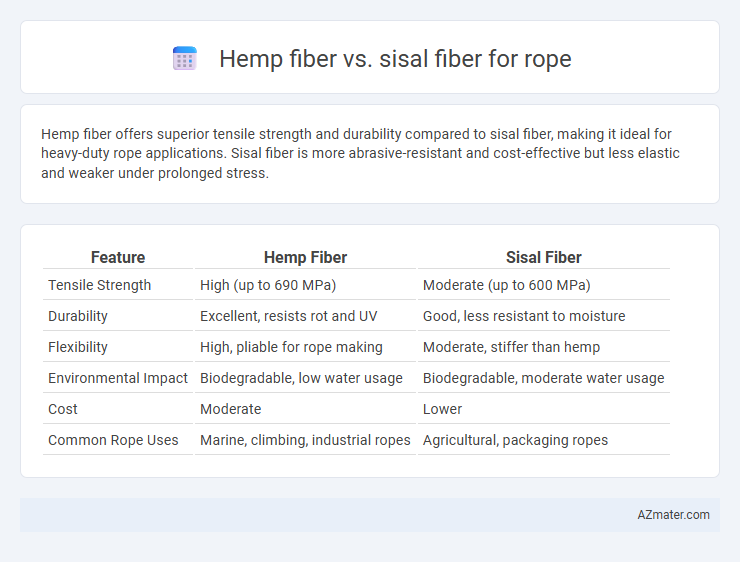Hemp fiber offers superior tensile strength and durability compared to sisal fiber, making it ideal for heavy-duty rope applications. Sisal fiber is more abrasive-resistant and cost-effective but less elastic and weaker under prolonged stress.
Table of Comparison
| Feature | Hemp Fiber | Sisal Fiber |
|---|---|---|
| Tensile Strength | High (up to 690 MPa) | Moderate (up to 600 MPa) |
| Durability | Excellent, resists rot and UV | Good, less resistant to moisture |
| Flexibility | High, pliable for rope making | Moderate, stiffer than hemp |
| Environmental Impact | Biodegradable, low water usage | Biodegradable, moderate water usage |
| Cost | Moderate | Lower |
| Common Rope Uses | Marine, climbing, industrial ropes | Agricultural, packaging ropes |
Introduction to Hemp and Sisal Fibers
Hemp fiber, derived from the stalks of the Cannabis sativa plant, is renowned for its exceptional tensile strength, durability, and resistance to environmental degradation, making it a preferred material for durable ropes and cords. Sisal fiber, extracted from the leaves of the Agave sisalana plant, is naturally coarse, robust, and biodegradable, commonly used in making ropes, mats, and brushes due to its affordability and resistance to wear. Both fibers are renewable plant-based materials, with hemp offering superior strength and longevity, while sisal provides an economical and sustainable option for rope manufacturing.
Botanical Origins and Production Methods
Hemp fiber, derived from the Cannabis sativa plant, is obtained through retting and decortication processes that separate the bast fibers from the stalk, resulting in strong, durable strands ideal for rope-making. Sisal fiber comes from the leaves of the Agave sisalana plant, extracted by mechanical decortication, which crushes the leaves to release stiff, coarse fibers suitable for rougher rope applications. Both fibers differ significantly in their botanical origins and production methods, influencing their texture, strength, and environmental impact in rope manufacturing.
Physical Properties Comparison
Hemp fiber exhibits superior tensile strength, averaging 550 MPa, compared to sisal fiber's 400 MPa, making it more durable for heavy-duty rope applications. Hemp's fibers are longer, typically 3 to 15 inches, which enhances flexibility and reduces fraying, while sisal fibers are shorter, around 3 to 8 inches, resulting in a coarser texture. Moisture absorption rates differ significantly: hemp absorbs about 12% moisture, improving resistance to rot and mildew, whereas sisal absorbs up to 20%, which can compromise rope longevity in humid conditions.
Strength and Durability Analysis
Hemp fiber exhibits superior tensile strength reaching up to 800 MPa, making it one of the strongest natural fibers used in rope manufacturing. Sisal fiber offers moderate strength, typically around 600 MPa, but provides excellent abrasion resistance and durability in harsh environmental conditions. The natural lignin content in sisal enhances its durability against moisture and UV exposure, while hemp's long, strong fibers contribute to higher load-bearing capacity and longevity in dynamic applications.
Environmental Impact and Sustainability
Hemp fiber offers superior environmental benefits compared to sisal fiber, as it requires less water, fewer pesticides, and grows faster, making it a more sustainable choice for rope production. Hemp's carbon sequestration capabilities and biodegradability contribute to reduced ecological footprints, while sisal cultivation often involves intensive land use and chemical inputs. Choosing hemp rope supports sustainable agriculture and promotes eco-friendly material sourcing in the textile industry.
Cost and Economic Considerations
Hemp fiber generally costs more than sisal fiber due to its more complex cultivation and processing methods, but it offers superior durability and strength, making it economically viable for long-term heavy-duty rope applications. Sisal fiber is less expensive and more readily available, which reduces initial rope production costs, making it a practical choice for short-term or budget-sensitive projects. Evaluating cost-efficiency depends on the rope's intended use, with hemp providing greater value over time despite higher upfront investment.
Applications in Rope Manufacturing
Hemp fiber offers superior strength and durability, making it ideal for heavy-duty ropes used in maritime and industrial settings. Sisal fiber provides excellent abrasion resistance and rigidity, commonly applied in agricultural and decorative ropes. Both fibers are biodegradable and eco-friendly, but hemp's higher tensile strength suits applications requiring long-lasting performance.
Performance in Various Conditions
Hemp fiber demonstrates superior tensile strength and durability compared to sisal fiber, making it more resistant to abrasion and wear in harsh environments. Sisal fiber, while strong, tends to absorb more moisture, leading to faster degradation in wet or humid conditions, whereas hemp retains its integrity and resists rot. Both fibers offer good UV resistance, but hemp's natural oils provide enhanced protection against microbial attack, extending rope lifespan under diverse weather conditions.
Maintenance and Lifespan of Ropes
Hemp fiber ropes exhibit superior resistance to moisture, mold, and UV exposure, resulting in lower maintenance requirements and a longer lifespan of up to 20 years when properly cared for. Sisal fiber ropes, while biodegradable and cost-effective, degrade faster due to susceptibility to rot and wear, typically lasting around 6 to 8 years under similar conditions. Optimal maintenance of hemp ropes involves regular drying and minimal chemical exposure, whereas sisal ropes demand frequent replacement and careful storage to prolong usability.
Conclusion: Choosing the Right Fiber for Rope
Hemp fiber offers superior strength, durability, and resistance to UV light, making it ideal for heavy-duty rope applications exposed to harsh outdoor conditions. Sisal fiber, while less durable, provides a cost-effective, biodegradable option suitable for general-purpose ropes and indoor use. Selecting the right fiber depends on the specific requirements of rope strength, environmental exposure, and budget constraints.

Infographic: Hemp fiber vs Sisal fiber for Rope
 azmater.com
azmater.com